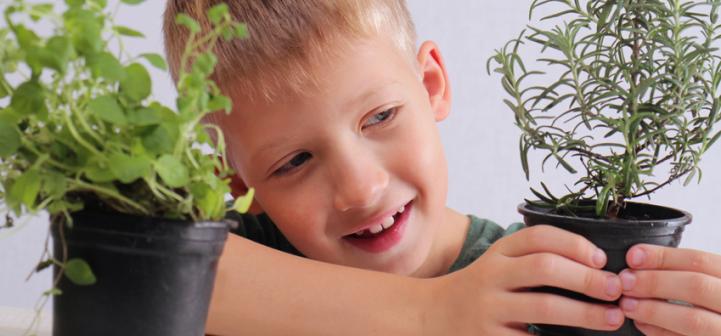
Garden-based learning activities in the classroom promote science, math, reading, and allow students to increase their awareness of the environment and nutrition. With enough creativity, the garden and garden activities can be applied to just about any lesson taught in the classroom, and be integrated into existing school curricula. Studies have found that incorporating a school gardening program into science curriculum improves student achievement more than traditional methods (Klemmer, Waliczek, & Zajicek, 2005).
Tips for Developing Indoor Gardens
The following tips provide some ideas for using indoor gardening during the school year:
- Getting Started– Use small containers to begin the process (recycled milk containers can work) and find a location with plenty of sunlight. The most important consideration is how the container will drain excess water. Once the plants begin to grow, they may require transfer to a larger container. For more information on how to get started, visit Utah State University’s School Gardens page.
- Ordering Seeds – To save money on seeds, try ordering from a major mail-order company that sells seeds in larger quantities rather than in packets. Some seed companies are willing to discount or donate last year’s seeds if you call and ask.
- Garden in Different Containers – Any containers can be used to grow a plant, if it can hold soil, drain water, and is large enough to support a plant. Pots, window boxes, and even shoes can be used in an indoor garden. This allows students to be creative and make predictions on the growth of different plants. For more information on this lesson plan, go to the Gardening Containers from the National Gardening Association.
- Edible Plants– Grow edible fruits and vegetables in the classroom and have students taste test different parts of the plants that they may not have tried before, such as the stem and leaves. This activity can increase students’ awareness of nutritious foods and food sources. Windowsill gardens can support beets, collards, carrots, lettuce, Swiss chard, turnips, and herbs. If your indoor garden has a grow light, it can support even more fruits and vegetables.
- Make it Mobile – If you have multiple classrooms interested in the project and only limited space or limited sunlight from the window, make your garden mobile. A wagon, utility cart or even a grocery cart can be made into a mobile garden and transported to multiple classrooms or positioned in different parts of the school to get optimal sunlight. Check out the micro farm example at Utah State University’s School Gardens page.
- Send out a Call for Help or Donations: Posting a short blurb in your school newsletter or the local garden clubs requesting help for seed and materials donations or someone to help build a garden cart will almost always bring results.
- Fundraising– The National Gardening Association has twenty Youth Garden Grants available to support non-profit, school, and youth programs that are interested in a new garden program or expanding a current program. For more information and a link to the grant application, see the Youth Garden Grant page. Slow Food USA also maintains a list of more than 20 grants available for school gardens.
Incorporating a garden in the classroom is a great way to get students excited about learning with hands on activities while encouraging health eating and exposing students to new fruits and vegetables.
For more school garden resources, click here!
Contributors
Maureen Hosty, Oregon State University Extension
Rachel Watkin, Cornell University
Sources
http://gardening.cce.cornell.edu/
Klemmer, C.D., Waliczek, T.M., & J.M. Zajicek. (2005) Growing Minds: The Effect of a School Gardening Program on the Science Achievement of Elementary Students. HortTechnology. Volume 15, Issue 3, Sept 2005, Pages 448-452.
